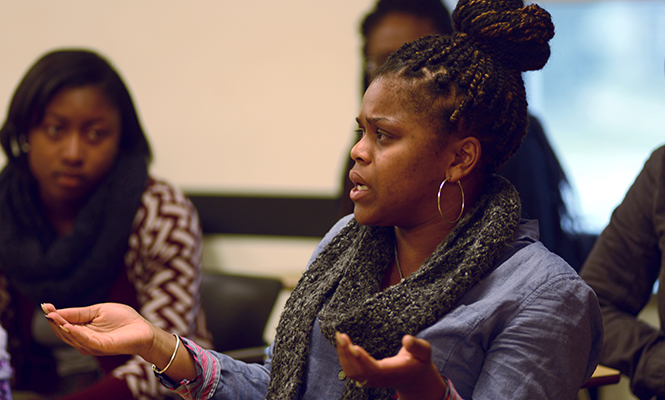Students express concerns about racial profiling in release of suspect description
Savanna Mccarthy, a freshman student in Traci Williams ‘Black Images’ class at Kent State University participates in a discussion on how the gun shot on campus last night was handled on April 3, 2014.
April 3, 2014
Trey Walker and his friend, both black men, were en route to their residence hall briefly after the lockdown was lifted across campus Wednesday night. He told his friend to remove his hood so they were not mistaken for Quavaugntay Tyler, the 24-year-old freshman criminology and justice studies major suspected of firing a shot outside Bowman Hall Wednesday.
“It’s sad this was my initial thought after I was the one on lockdown,” said Walker, a freshman broadcast journalism major. “This situation puts me and my friends in the position of being thought of as capable of committing such an act because we are black men.”
Walker was afraid of being racially profiled and harassed by the Kent State Police after the description of the shooting suspect, “a black man wearing black basketball shorts and carrying a silver handgun,” was released via campus alerts.
In Traci Easley Williams’ Black Images course Thursday afternoon, Walker and other students expressed their views and stories about how Tyler was identified as simply a “black male.”
Easley Williams, a professor of Pan-African studies and journalism, asked her class by show of hands how many of them believed they should have released the description of Tyler as a “black man” even though it was vague.
Only one student — Caleb Ference, a senior electronic media production major — raised his hand.
Ference, a white student, did not believe the suspect’s race should have been released because it was very broad, but he said a statement was necessary so that he could be recognized by the public.
“It was a very hectic situation, and I believe people should have known,” Ference said. “Not releasing the statement could have avoided this situation in some ways, but it would not have eased the tension that was going on.”
Easley Williams said she does not believe it is fair that minority students have to face situations like this and carry the backlash while keeping up with all other responsibilities in college.
Jamal Deakings, a sophomore electronic media production major, said he admitted to initially feeling relief when he received the campus alert identifying the suspect of the shooting as a “black man.”
“When I found out he was a black man with a handgun, I was actually relieved because I believed it was less likely it was going to be a mass shooting,” Deakings said.
Freshman broadcast journalism major Valerie Williams said she was surprised to hear the suspect was black.
“I was completely shocked; I honestly did not expect him to be black,” Williams said. “Most major school shootings are done by Caucasian people, so I did not think the suspect would have been black.”
For Williams and Ashley Coker, a sophomore fashion merchandising student, the discussion took an emotional turn because they were friends with the suspect.
“I know this person, and it hurts me because everything that he worked for is now going to be thrown away because of one incident,” Coker said.
Savanna McCarthy, a freshman broadcast journalism major, said she does not feel the public will ever be able to hear his side of the story.
“Why did he have a gun, and why did he feel threatened enough to pull the gun out?” McCarthy said. “I feel like no one is going to sit down and take out the time to get that information.”
Senior public health major Nathaniel Lewis said this was not the first time a general description has been released, especially one that was geared toward African-Americans.
“This time was different and a lot more serious because it was associated with a shooting,” he said.
Lewis said he was not wearing basketball shorts, but he was still scared the police might suspect he was the shooter.
Justine Ingram, a freshman criminology and justice studies major, had a different initial reaction from the rest of the class.
“As a black female, I am not upset they released a statement of him being black,” Ingram said. “I was frantic, and if there is a shooter, I want to know what he or she looks like.”
She said she was more upset to find out the suspect was black.
“I do not feel that bad for him because the situation could have escalated, and it only takes one person in the black community to put us all in a situation to be racially profiled.”
Leah Infante, a senior teaching English as a second language major who is white, said she did not have an initial reaction when she found out the student was black.
“I was really scared by the situation; my first thought was the Virginia tech shooting,” Infante said. “I was confused and nervous. If I was a black male in that situation, I would have definitely been scared as well.”
Lewis, who said this has happened before, said all tuition-paying students have the right to feel protected.
“I believe it is the university’s job to make sure as students, we feel protected and have all the necessary things to help us be successful,” he said.
Video by Alexa Maslowski.
Contact Kara Taylor at [email protected].












